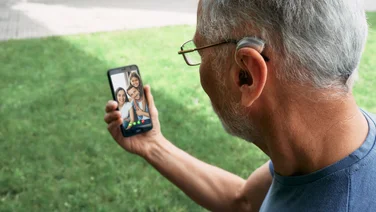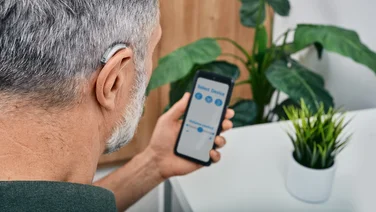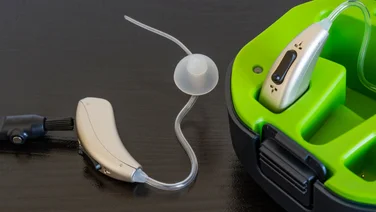To help us provide you with free impartial advice, we may earn a commission if you buy through links on our site. Learn more

Hearing aids have come a long way from the chunky stereotypes of decades past. Now, there are many types of hearing aids to choose from. In-ear hearing aids now fit entirely inside your outer ear, so they’re more discreet and comfortable than bigger BTE models. They’re not invisible; for that, you’ll need a completely-in-canal (CIC) hearing aid. But many ITE models are as small as earbuds, and you can get them in a whole range of funky designs if you want to look like you’re listening to music rather than wearing hearing aids.
Cheaper ITE aids are among the most affordable hearing aids you can buy. Own-brand models such as the Hearing Direct HD 230 (currently £206/single, normally £230) and the Specsavers Advance Star (£495/pair) come in at less than £500 per pair. But you’ll also find ITE hearing aids at the top end of the price, power and functionality scale.
Read on for a deeper dive into the pros and cons of in-the-ear hearing aids, including their sound-enhancing features, comfort levels and price.
If you have an idea of your requirements, you can use our free quote finder tool to be matched up with a local hearing specialist.
Get a free quote for hearing aids today
Take our quick survey below to find out how much hearing aids could cost you.
In-ear hearing aids: Everything you need to know
What are in-the-ear hearing aids?
In-the-ear (ITE) hearing aids fit inside your outer ear, instead of behind it (like BTE) or deep inside your ear like CIC, aka invisible hearing aids. For more about hearing aids that are so small no-one can see them (except you when you need to find them, we hope), see our article on invisible hearing aids.
You can now get earbud-style ITE hearing aids that don’t have to be moulded to your ears, but most ITE hearing aids are custom-moulded to fit snugly into the bowl-shaped area in your ear and your ear canal. Many people say they’re the most comfortable hearing aids you can wear.
Custom ITE aids come in two sizes: full-shell, which completely cover the wearer’s inner ear, and half-shell, which are more the size of earbuds. Some models, such as Philips Hearlink, are available in full-shell and half-shell:

Each single ITE hearing aid packs in every required electronic component: microphone, amplifier, processor, battery and speaker (aka receiver). A pair of ITE hearing aids has twin microphones, which help to provide balanced and natural sound quality.
READ NEXT: How do hearing aids work?
What are the advantages of ITE hearing aids?
ITE hearing aids are the Goldilocks of hearing aids: not too small, and not too big. That in-between size accounts for most of their advantages…
- ITE hearing aid models are big enough to have a power output that supports excellent sound quality and amplification. A good pair of ITE hearing aids can deliver the amplification, noise reduction and sound enhancement needed by people with moderate to severe hearing loss, as well as people with mild hearing loss. Some ITE hearing aids also support extra functions such as tinnitus masking and advanced feedback management.
- They’re big enough to be easy to handle. Smaller ‘invisible’ (completely-in-canal, or CIC) hearing aids can be extremely fiddly to insert, remove and adjust, and easy to lose. But ITE hearing aids are large enough for most users to handle with confidence. Their batteries are also bigger and longer lasting than CIC hearing aid batteries, but smaller than BTE batteries.
- Most ITE hearing aids are small enough to be lightweight and discreet. They may not be invisible, but if you wear your hair over your ears, no-one need know that you’re wearing a hearing aid. The fact that they’re custom-fitted to each user makes them more comfortable than other types of hearing aid, and the absence of any device behind your ear means you can wear glasses with ease, not to mention hats and headphones.
- They’re big enough to accommodate extra components such as volume control and directional microphones, plus add-ons such as telecoils. Telecoils are small magnetic coils of copper that can pick up electromagnetic signals, and make it easier to hear phone conversations and sounds in busy public places via induction loop systems.
What are the disadvantages of ITE hearing aids?
Given their relatively small size, ITE hearing aids are not as powerful as larger BTE models. BTE hearing aids can now help people with hearing loss greater than 65 dBHL (decibel hearing loss), classed as severe, while ITE models are best suited to people with hearing loss of between 25 and 65 dBHL. A qualified audiologist will be able to advise you on the type of hearing aid that best suits your level of hearing loss.
Here are a few more drawbacks to ITE hearing aids…
- Some of the smaller and more closely-fitted ITE hearing aids may be too fiddly to handle comfortably, especially for people with dexterity issues. If you have trouble using small controls, look for ITE hearing aids that you can control remotely via an app or remote device.
- Many ITE hearing aids are tiny from the outside, but they’re not invisible, if this is a concern for you. Some full-shell ITE aids are actually quite big, and fill almost the wearer’s entire inner ear.
- The part of ITE hearing aids that fits into the ear canal can be too big for people with narrow canals, and not suitable if you suffer frequently from ear infections.
- Cleaning can be an issue with ITE hearing aids, because they sit so snugly in your ear and can get clogged with earwax.
- Repairs also tend to be more of an issue with ITE hearing aids than with BTE models, largely because there are so many components squeezed into a tiny moulded plastic device. The close proximity of all those components can also cause feedback issues.
- Occlusion is another potential audio problem, particularly with full-shell ITE hearing aids. This is when your ears feel blocked, so your own voice sounds strange or loud, and chewing food is uncomfortable. Some models have special air vents to help avoid this.
How much do ITE hearing aids cost?
ITE hearing aids vary greatly in price, because they vary greatly in power and features. Custom fitting adds a little to the price compared with off-the-shelf models, but some of the cheapest hearing aids are ITE.
You may not see budget hearing aids in the most prominent places on retailers’ websites, so we went looking for them. One of the best deals we found was the Hearing Direct HD 230, a discreet ITE digital hearing aid currently on special offer at £370/pair or £206 each (normally £230 each).
The most budget-friendly ITE hearing aid in the Specsavers range is the Specsavers Advance Star (£495/pair), while the most expensive is the Signia Active Pro (£2,795), which looks like a sleek pair of fitness earbuds but packs in an astonishing array of audio-enhancing functions.
There’s plenty of choice in between. The popular Signia Silk 1Nx (£598/pair or £349 each from Hearing Direct) are colour-coded so you instantly know which one is left or right, and they have four sound environment presets, although the ability to minimise background noise may be limited in this price range. The free Signia app works as a remote control for all Signia hearing aids, and also lets you keep an eye on your hearing aid’s battery and connectivity.
READ NEXT: Boots hearing aids prices, explained
Can I get ITE hearing aids on the NHS?
It’s unlikely. Most hearing aids issued through the NHS today are digital BTE models. If you want something relatively discreet on the NHS, your best bet may be a receiver-in-the-ear (RITE) hearing aid, which is a small BTE model with a clear plastic cable or wire that goes to a small speaker inside your ear canal.
READ NEXT: Specsavers hearing aids prices, explained
How do I choose the best ITE hearing aid for me?
Choosing the best hearing aid for you requires the help of a trained audiologist. They can take accurate measures of your hearing loss and type, and take into account the factors that matter to you. If you’re looking for an ITE hearing aid, your audiologist will also be able to take an accurate mould of your ear, which the hearing aid will be custom-built to fit perfectly into.
Use our quote-finder tool below to find out what type of hearing aid would best suit you, and to discuss the best options for helping you hear more easily and clearly.






